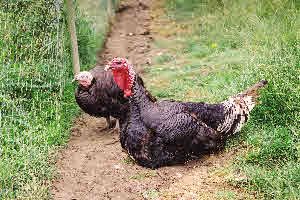 Housing Your Turkeys
Housing Your Turkeys
Turkeys need a secure warm shelter to sleep in at night with space of at least 4 sqft ( 0.4M2) per bird and ventilation above head height so they are not affected by drafts. The ideal is 2 birds per M2 with a minimum perch space of 40cm per bird. Converted sheds or large coops are ideal and roosting areas should be provided if possible as some breeds of turkeys enjoy roosting at night.
The flooring in their housing should be covered with a layer of wood shavings, sawdust, or hemcore but avoid hay or straw bedding as this will absorb the ammonia smell of the droppings and hay can contain harmful spores that can cause respiratory infections in all poultry.
Turkey Runs & Security
Most breeds of turkey are capable of flight and you need to consider this when designing any runs for them or if you wish for them to fully free range. A six-foot fence will contain most birds but they can manage to fly up to 8 foot so this would be the ideal height of fencing. Alternatively you can cover the run they are in.
If free ranging, turkeys will usually return home to roost in their house however, they do need a little more encouragement that chickens and ducks and if left totally to their own devices you may find them roosting in trees or even on top of their house instead of in it!
When breeding for the table a lot of people choose to keep the turkeys in their house until they are table ready. If this is the case an extra 4 sqft per bird should be given as a minimum. You should also provide entertainment in the form of perches, dangling cds, dangling vegetables and even small balls to play with so that boredom doesn’t lead to fighting and pecking of one another.
Clean shavings must be regularly topped up to avoid respiratory infections
Feeding Turkeys
There are many suppliers of specific turkey feeds to cover them through their various life stages and to prepare them for the table. Turkeys require a far higher protein content in their food to support their growth rate than other poultry. Chick or duck starter crumbs do not provide them with everything they require to grow properly.
Turkey starter crumb has a protein content of around 24-28% and this should be fed to the turkey poults until they reach around 6-8 weeks of age. At this age the poults should be moved over onto a growers/finisher ration, which has slightly less protein (around 20% content).
This should be done gradually over a two-week period and if you are rearing your turkey for the table generally you should keep the poults on this until they are ready for the table.If you are keeping the turkey as a pet, for showing or for eggs for breeding you should swap them onto a maintenance layers pellet at 18 weeks of age. Again, this should be gradually swapped over a two-week period.
Mixed Flocks
If you are keeping a mixed flock your adult turkey may be kept on the same pellets as your ducks or geese. It is only in the early stages that they require the higher protein levels for their development.
Turkeys will happily range and eat grass, worms, grubs and plants if allowed to. This will not harm them, although their diet should consist mainly of pellets in order to make sure they receive all the nutrients they require.
Further Articles on Keeping Turkeys
- Breeding Turkeys – Genetics & Stock
- Breeding Turkeys – Incubating & Hatching Turkey Eggs
- Breeding Turkeys – Introducing Sexes & Mating Turkeys
- Breeding Turkeys – Turkey Rearing: Good Stock
- Guide to Keeping Turkeys – Housing & Feeding Turkeys
- Guide to Keeping Turkeys – Introduction & Turkey Breeds
- Guide to Keeping Turkeys – Turkey Diseases
- Guide to Keeping Turkeys – Turkey Health
- Guide to Keeping Turkeys – Turkey Parasites & Poison

